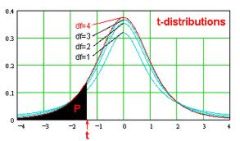Confidence Interval Calculator for the Mean (Unknown Pop. Standard Deviation)
Instructions: Use this Confidence Interval Calculator for the population mean \(\mu\), in the case that the population standard deviation \(\sigma\) is not known, and we use instead the sample standard deviation \(s\). Please type the sample mean, the sample standard deviation, the sample size and the confidence level, and the confidence interval will be computed for you:
Confidence Interval Calculator T
More about the confidence intervals for you to have a better understanding of the results obtained by this calculator
A confidence interval is an interval (corresponding to the kind of interval estimators) that has the property that is very likely that the population parameter is contained by it (and this likelihood is measure by the confidence level).
Properties of Confidence Intervals
In this case the population parameter is the population mean (\(\mu\)). Confidence intervals have several properties:
- They correspond to an interval that is very likely to contain the population parameter being analyzed
- Such likelihood is measured by the confidence level, that is set at will
- The higher the confidence level, the wider the confidence interval is (if everything else is equal)
- For confidence intervals for \(\mu\), they are symmetric with respect to the sample mean, this is the sample mean is the center of the interval.

Confidence Interval Formula For One Sample: t Distribution
The formula for a confidence interval for the population mean \(\mu\) when the population standard deviation is not known is
\[CI = (\bar x - t_{\alpha/2, n-1} \times \frac{ s }{ \sqrt n }, \bar x + t_{\alpha/2, n-1} \times \frac{ s }{ \sqrt n })\]where the value \(t_{\alpha/2, n-1}\) is the critical t-value associated with the specified confidence level and the number of degrees of freedom df = n -1.
For example, for a confidence level of 95%, we know that \(\alpha = 1 - 0.95 = 0.05\) and a sample size of n = 20, we get df = 20-1 = 19 degrees of freedom, and using a t-distribution table table (or Excel) we find that \(t_{0.025, 19} = 2.093\).
Observe that this is not only a 95 confidence interval calculator, but you can select the confidence level that you desire. If that is the level of confidence you desire, the 95 confidence interval formula will differ from others ONLY in the critical t-value used, and the rest will be the same.
Interpretation of the Confidence Interval
How to interpret the results for this confidence interval for population mean calculator? What we are obtaining is an interval estimate of the population mean from which the sample used comes from.
This interval found gives us a region when are confident to expect that the true population mean will be located at. For example, if we found that the 95% confidence interval for the mean is (45.6, 48.9), then we can be 95% confident that the true mean will be contained in the range (45.6, 48.9)
Often times, the 95% confidence interpretation is wrongly expressed as a probability that the population parameter is on the given interval, but such interpretation is rather incorrect.
The reason for this is that the population parameter is not a random variable, there is not a probability associated to it and it is either in a given interval or not, and there is not a probability that it is there. If you want to learn more about this, search for Bayesian estimation.
When to you use the normal distribution instead
If you instead know the population standard deviation, you should use our Confidence Interval Calculator for the Mean with known Population Standard Deviation . There are other confidence intervals you can use such as the confidence interval for the sample variance, the confidence interval for slope coefficients, or confidence intervals and prediction intervals for regression estimate .




